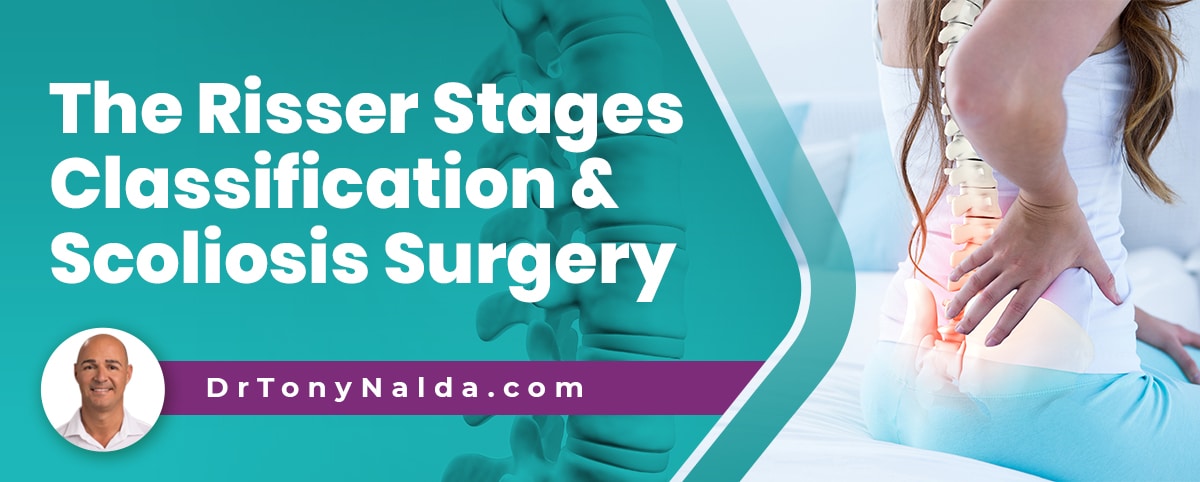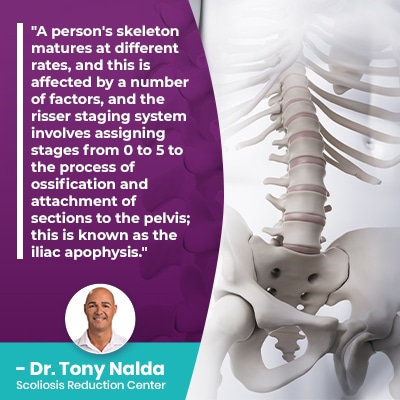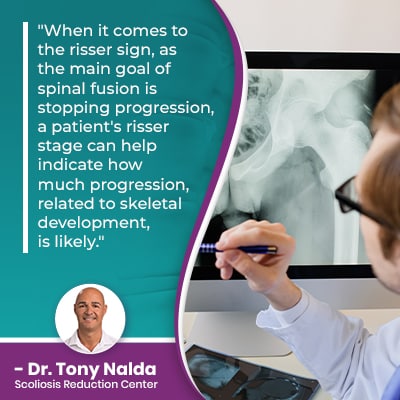The Risser Stages Classification & Scoliosis Surgery

Part of the challenge of treating scoliosis is its progressive nature. While there is no single test to definitively determine a patient's progressive rate, certain patient/condition characteristics help me predict a patient's likeliest rate of progression. The biggest indicator of progression is growth potential as growth and development is the condition's main progressive trigger, and this is where the risser stages classification comes in.
As a progressive condition, the nature of scoliosis is to get worse over time, and using a number of variables to gauge a patient's likely rate of progression is a strategy of treatment. The Risser stage classification system determines a patient's level of skeletal maturity because growth triggers progression.
Let's start our discussion of the Risser score by first exploring why it's needed and how it can help shape the design of effective treatment plans.
Table of Contents
Scoliosis Progression
A diagnosis of scoliosis means an unnatural sideways spinal curvature has developed, and in addition to bending unnaturally to the side, a scoliotic curve also twists unnaturally, making it a complex 3-dimensional condition.
In addition, in order to be officially diagnosed as scoliosis, the unnatural spinal curvature has to be of a minimum size: Cobb angle measurement of at least 10 degrees.
A patient's Cobb angle is a key piece of information as it tells me how far out of alignment a scoliotic spine is, and classifies conditions in terms of severity:
- Mild scoliosis: Cobb angle measurement of between 10 and 25 degrees
- Moderate scoliosis: Cobb angle measurement of between 25 and 40 degrees
- Severe scoliosis: Cobb angle measurement of 40+ degrees
- Very-severe scoliosis: Cobb angle measurement of 80+ degrees
Now, the condition's severity levels shape the crafting and customization of treatment plans, and they also indicate the condition's progressive line.
So where a condition is at the time of diagnosis doesn't mean that's where it will say, especially without the help of proactive treatment methods.
When scoliosis progresses, the unnatural spinal curve is increasing in size, becoming more rigid, less responsive to treatment, and also making it harder for patients to perform certain therapeutic exercises that are an important facet of treatment; this is why it's always best to start treatment immediately following a diagnosis.
What Causes Scoliosis to Progress?
In addition to ranging widely in severity and being a progressive condition, scoliosis is also considered a complex condition to treat because it has multiple types.
The most prevalent type of scoliosis is idiopathic scoliosis, and the idiopathic designation means not clearly associated with a single-known cause, and the most prevalent form of scoliosis overall is adolescent idiopathic scoliosis, diagnosed between the ages of 10 and 18.
So when it comes to predicting scoliosis progression, patient age is a huge indicator; the more growth a patient has yet to go through, the further they are from reaching skeletal maturity, and the more their scoliosis is likely to progress.
In adolescent idiopathic scoliosis, rapid-phase progression is a concern as puberty is characterized by rapid and unpredictable growth spurts.
So you can likely imagine how helpful it is to have an idea as to how much growth a patient has yet to go through, and this is where the risser classification comes in.
Risser-Ferguson Method
Officially known as the Risser-Ferguson method, the risser classication can help determine how much growth a patient has yet to go through before reaching skeletal maturity; that way, we can gauge how important monitoring for progression is going to be throughout the course of a patient's scoliosis treatment.
So while a patient's Cobb angle can help assess scoliosis in terms of severity, the Risser-Ferguson method can help assess a patient's level of skeletal maturity and further progression.
It is also important to understand that even in adult scoliosis patients who are no longer growing, progression will still occur, just likely at a slower rate.
 A person's skeleton matures at different rates, and this is affected by a number of factors, and the risser staging system involves assigning stages from 0 to 5 to the process of ossification and attachment of sections to the pelvis; this is known as the iliac apophysis.
A person's skeleton matures at different rates, and this is affected by a number of factors, and the risser staging system involves assigning stages from 0 to 5 to the process of ossification and attachment of sections to the pelvis; this is known as the iliac apophysis.
Ossification refers to how bone tissue is formed, and a patient's level of bone formation can be a sign in the management of scoliosis patients.
The higher the ossification stage, the closer to reaching skeletal maturity a patient is, and the lower the ossification stage, the further away a patient is from fulfilling their growth potential.
This type of information can help with the crafting of an effective treatment plan because each patient's growth velocity and progressive rate is different, and the more bone growth a patient still has to go through, the more that new bone growth is likely to impact progression.
So if a patient has experienced complete ossification of the iliac crest apophysis, they have likely reached their peak height velocity and won't be experiencing further trunk growth.
While there are no treatment guarantees, early detection and intervention does increase the likelihood of treatment success, as does knowing condition severity through a patient's Cobb angle, and remaining growth through applying the risser scale.
The more information I have about a patient's scoliosis, the more customized their treatment plan can be, and this helps impact the condition on every level.
While most cases of scoliosis can be treated without surgery, for those on the path of traditional treatment, spinal fusion is likely to be recommended.
Scoliosis Surgery and Traditional Treatment
Scoliosis treatment methods can be surgical or non-surgical, and for those who choose the traditional scoliosis treatment approach, once a patient progresses into the severe classification with a Cobb angle of 40+ degrees, they become a surgical candidate.
 When it comes to the risser sign, as the main goal of spinal fusion is stopping progression, a patient's risser stage can help indicate how much progression, related to skeletal development, is likely.
When it comes to the risser sign, as the main goal of spinal fusion is stopping progression, a patient's risser stage can help indicate how much progression, related to skeletal development, is likely.
So for patients with a low risser score, this indicates there is a lot of growth remaining prior to reaching full skeletal maturity, and this can be a further motivation behind a surgical recommendation.
Spinal fusion involves fusing the curve's most-tilted vertebrae into one solid bone to eliminate movement (progression) in the area, and rods are commonly attached to the spine with pedicle screws to hold the spine in place.
While spinal fusion can help straighten a bent spine, there are no guarantees, and the way in which surgery stops progression can come at the cost of the spine's overall health, strength, and function.
A spine that's fused is fused for life, and if there are any issues such as continued progression, adverse reaction to hardware used, or hardware malfunction, there is no recourse other than more surgery.
While some patients still maintain enough flexibility in the areas above and below the spine's fused section to not experience a noticeable loss in spinal flexibility and range of motion, for many patients, this is the most disappointing result, and in addition, a spine that's fused is not going to be as strong so is more vulnerable to spinal injury.
Fortunately for those who choose to forgo a surgical recommendation, or who simply want to try a less-invasive scoliosis treatment option first, there is a non-surgical conservative scoliosis treatment method with proven results.
Conclusion
When it comes to treating scoliosis, there are two main approaches to choose between: traditional and conservative.
While traditional treatment often funnels patients towards spinal fusion surgery, one of the goals of conservative scoliosis treatment is to help patients avoid the need for surgery, and its potential side effects and complications.
The french risser staging system can help determine a patient's skeletal age and vertebral growth potential, as this indicates how strongly a condition is going to be triggered to progress; pubertal growth can cause rapid-phase progression.
When it comes to treating adolescent idiopathic scoliosis, a large focus of treatment is on monitoring for progression and observing how a patient's spine is responding both to growth and treatment.
Treatment decisions are shaped by important patient/condition features, and the higher risk of progression there is, the more growth a patient has yet to go through, and as the management of scoliosis isn't a simple process, the more information I have about a patient's condition, the better.
Bone formation is an important part of scoliosis as the vertebral growth plates play key roles in the spine's longitudinal growth and curve progression.
The Scoliosis Research Society puts current estimates at close to seven million people currently living with scoliosis in the United States alone, so scoliosis is a highly-prevalent spinal condition that needs to be treated proactively.
Here at the Scoliosis Reduction Center, I offer patients a chance to correct their scoliosis through conservative scoliosis treatment that works towards reducing a scoliotic curve on a structural level through chiropractic care.
I also integrate multiple treatment disciplines so treatment plans can be fully customized to address a patient's overall skeletal development, likeliest rate of progression, level of bone maturity, and other factors.
Physical therapy can help with strengthening the spine's surrounding muscles so the spine is optimally supported, and corrective bracing is particularly effective when treating adolescent idiopathic scoliosis; rehabilitation involves a series of custom-prescribed home exercises to further stabilize and heal the spine.
So regardless of a patient's level of skeletal maturity and condition severity, as a progressive condition, the best time to start treatment is always now, before conditions progress, making them more complex to treat.
Dr. Tony Nalda
DOCTOR OF CHIROPRACTIC
After receiving an undergraduate degree in psychology and his Doctorate of Chiropractic from Life University, Dr. Nalda settled in Celebration, Florida and proceeded to build one of Central Florida’s most successful chiropractic clinics.
His experience with patients suffering from scoliosis, and the confusion and frustration they faced, led him to seek a specialty in scoliosis care. In 2006 he completed his Intensive Care Certification from CLEAR Institute, a leading scoliosis educational and certification center.
About Dr. Tony Nalda
 Ready to explore scoliosis treatment? Contact Us Now
Ready to explore scoliosis treatment? Contact Us Now





